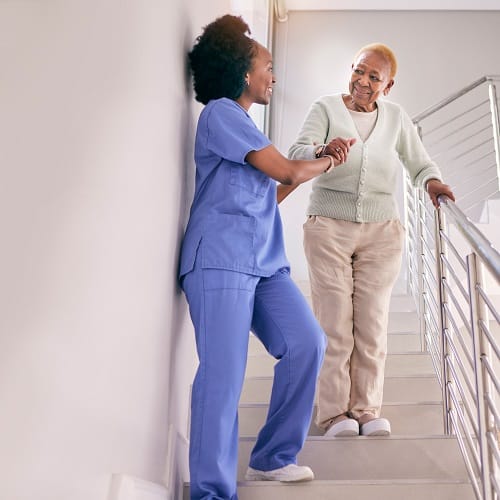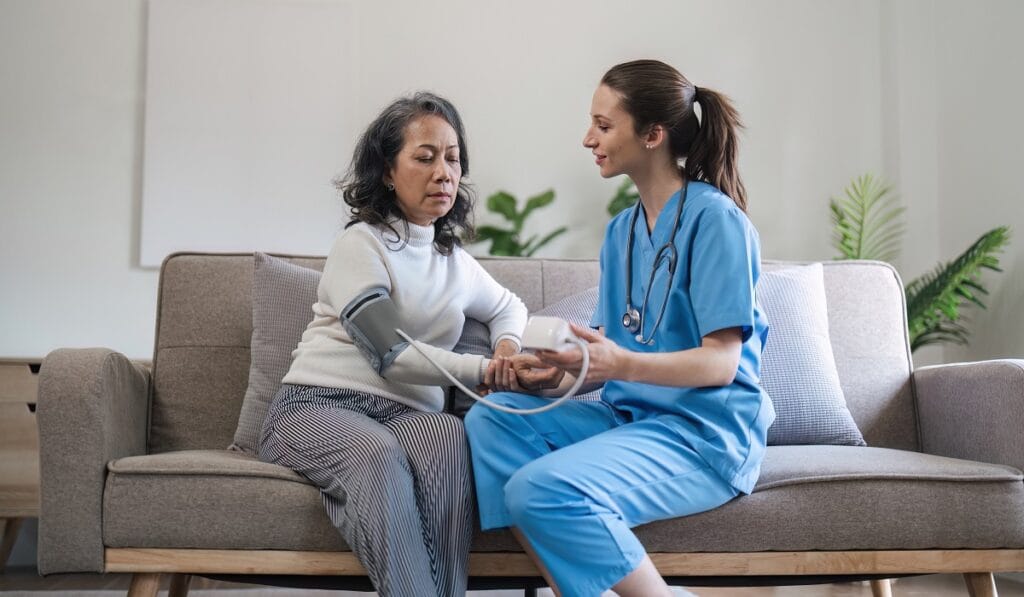When it comes to selecting an assisted living facility, safety is paramount. Assisted living communities must prioritize safety measures that protect seniors and promote their well-being. This guide covers critical safety measures in assisted living, including fall prevention, emergency preparedness, and health monitoring practices that keep residents secure and supported.

1. Key Safety Measures in Assisted Living Facilities
a) Overview of Safety Protocols in Assisted Living
In assisted living facilities, safety protocols are designed to protect residents from various risks. These safety measures in assisted living include emergency response readiness, health and safety assessments, and physical adjustments within the environment to accommodate residents’ needs.
Common Safety Protocols Include:
- 24/7 staffing for immediate assistance
- Secure access points to prevent unauthorized entry
- Routine safety assessments to identify and mitigate risks
b) Security Features for Resident Protection
To enhance safety measures in assisted living, facilities implement multiple security features to create a safe, controlled environment.
Key Security Measures Include:
- Restricted Access Areas: Controlling entry and exit points, especially for residents with memory issues
- Surveillance Systems: Monitoring common areas to assist with swift responses
- Visitor Screening: Ensuring only authorized individuals enter the facility
These resident protection features offer peace of mind for families, ensuring that their loved ones are safeguarded.
2. Fall Prevention: A Core Safety Measure in Assisted Living
a) Recognizing and Mitigating Fall Risks
One of the most crucial safety measures in assisted living is fall prevention. Assisted living facilities conduct assessments to identify fall hazards and implement safeguards accordingly.
Common Fall Hazards:
- Slippery surfaces and loose rugs in bathrooms
- Poor lighting in hallways
- Obstacles in walkways
b) Fall Prevention Strategies
Effective fall prevention strategies help ensure residents’ safety. These strategies include:
- Installing Grab Bars and Handrails: Offering support in key areas
- Encouraging Supportive Footwear: Promoting balance and stability
- Exercise Programs: Improving residents’ strength and mobility
Each resident undergoes an assessment to address their unique fall risks, providing personalized fall prevention measures tailored to individual needs.
3. Emergency Preparedness in Assisted Living Facilities
a) Developing a Comprehensive Emergency Plan
Preparedness for unexpected events is another critical safety measure in assisted living. Facilities follow emergency response plans that include:
- Evacuation Protocols: Staff and residents are trained to follow clear evacuation procedures.
- Fire Safety Measures: Equipped with alarms, fire extinguishers, and sprinklers
- Routine Emergency Drills: Practiced regularly to ensure readiness
b) Communication of Emergency Procedures
Clear communication of emergency preparedness procedures is essential to keep residents and families informed.
Key Communication Practices Include:
- Orientation for New Residents and Families: Detailed sessions on facility emergency plans
- Regular Safety Updates: Ensuring that everyone remains informed of any changes in protocol
4. Health Monitoring and Medical Support as a Safety Measure
Health monitoring is one of the vital safety measures in assisted living, as it enables early detection and response to potential health issues among residents.
a) Routine Health Monitoring
Assisted living facilities implement daily and periodic health checks to monitor residents’ wellness. This includes:
- Vital Sign Monitoring: Regularly checking blood pressure, heart rate, etc.
- Medication Management: Helping residents maintain their medication schedules
- Wellness Programs: Offering services like mental health support and dietary assessments
b) On-Site Medical Support
Immediate medical support is essential to residents’ safety. Most assisted living communities provide:
- Licensed Nursing Staff: Available to assist with medical needs
- On-Call Physicians: Physicians who visit the facility regularly and are available for emergencies
These health monitoring practices ensure that seniors receive timely care, contributing to their overall safety and well-being.
5. Training and Certification of Assisted Living Staff
The staff in assisted living facilities are trained in safety measures tailored to the specific needs of seniors.
a) Staff Training in Safety Protocols
Staff undergo rigorous training on emergency response, fall prevention, and first aid.
b) Ongoing Education
Continuous learning is essential for maintaining high standards in senior care safety. Staff members receive ongoing education on the latest safety protocols and resident protection practices, ensuring the best possible care.
FAQ Section
- What safety measures are in place in assisted living facilities?
Assisted living facilities implement a variety of safety protocols to ensure residents’ well-being. These include:
- 24/7 Staff Availability: Caregivers are always on hand to assist residents as needed.
- Secure Access Controls: Restricted entry points to prevent unauthorized access.
- Emergency Response Systems: In-room call buttons and alert systems for immediate assistance.
- Regular Safety Assessments: Routine evaluations to identify and mitigate potential hazards.
- Environmental Modifications: Installation of grab bars, non-slip flooring, and proper lighting to prevent falls.
Together, these protocols create a safe and supportive environment for residents.
- How do assisted living communities prevent falls among residents?
Fall prevention is a primary focus in assisted living communities. Measures include:
- Environmental Adjustments: Keeping spaces clear of clutter, ensuring proper lighting, and installing handrails.
- Personalized Assessments: Evaluating individual fall risk factors to tailor prevention plans.
- Exercise Programs: Encouraging balance and strength training to enhance stability.
- Supportive Footwear Policies: Recommending non-slip, supportive shoes for all residents.
- Caregiver Training: Educating staff on fall prevention techniques and resident supervision.
These measures significantly reduce fall risks for residents.
- What emergency protocols do assisted living facilities follow?
Assisted living facilities have established protocols to handle various emergencies, such as:
- Evacuation Plans: Well-defined routes and procedures for safely evacuating residents.
- Regular Drills: Conducting fire, natural disaster, and other emergency drills to ensure readiness.
- Emergency Supplies: Easily accessible first aid kits and emergency contact information.
- Communication Systems: Using intercoms, alarms, and personal alert devices for rapid communication.
- Coordination with Local Authorities: Working with emergency services to ensure a swift response.
These protocols ensure that emergencies are managed promptly and effectively.
- How is health monitoring conducted in assisted living homes?
Health monitoring in assisted living facilities includes several caregiver-supported practices, such as:
- Regular Vital Checks: Monitoring blood pressure and other key indicators to spot any changes in health.
- Medication Management: Assisting residents with following their medication schedules and observing for side effects.
- Routine Health Assessments: Checking in with residents to monitor their well-being and any visible health concerns.
- Referral to Family and Healthcare Providers: Caregivers inform family members and coordinate with doctors or specialists as necessary.
These practices provide residents with continuous oversight and early intervention if needed.
- Are assisted living facilities safe for seniors with dementia?
Many assisted living facilities are equipped to safely care for seniors with dementia by:
- Specialized Memory Care Areas: Secure spaces to prevent wandering and ensure safety.
- Trained Caregivers: Staff trained in dementia care techniques and behavioral support.
- Structured Environments: Creating consistent routines and familiar settings to reduce confusion.
- Engaging Activities: Offering programs tailored to cognitive abilities to comfort and engage residents.
- Family Involvement: Encouraging family members to participate in care planning and visits.
These features help create a safe and supportive environment for seniors with dementia.
- What training do staff receive to ensure resident safety in assisted living?
Staff in assisted living communities undergo thorough training, which includes:
- Emergency Response Training: Equipping caregivers to manage evacuations and other emergencies.
- Fall Prevention Techniques: Teaching methods to help minimize fall risks for residents.
- First Aid Certification: Training in basic first aid to provide immediate care when needed.
- Medication Management Protocols: Helping residents follow prescribed medication schedules.
- Dementia Care Training: Understanding and supporting behaviors associated with memory loss.
Ongoing training ensures that caregivers stay updated on best practices and safety protocols.
- How do assisted living facilities handle medical emergencies?
In case of a medical emergency, assisted living facilities have clear protocols that include:
- Immediate Assessment: Caregivers assess the situation to determine the best course of action.
- First Aid Administration: Providing basic first aid when necessary until further assistance arrives.
- Emergency Services Contact: Quickly reaching out to 911 or local emergency responders.
- Family Notification: Informing designated family members promptly about the situation.
- Incident Documentation: Recording details for medical records and follow-up care.
These steps help ensure that residents receive prompt and appropriate care in emergencies.
- What security features are common in assisted living communities?
Common security features in assisted living communities include:
- Controlled Access: Entry systems that limit access to approved individuals.
- Surveillance Cameras: Monitoring common areas to deter unauthorized activity.
- Alarm Systems: Alerts for unauthorized exits, particularly in memory care units.
- Visitor Check-In Procedures: Requiring visitors to sign in and wear identification badges.
- Wander Management Systems: Systems that alert staff if residents with cognitive impairments attempt to leave designated areas.
These features ensure that residents live in a secure and closely monitored environment.
Conclusion
Choosing an assisted living facility that prioritizes safety is essential for the well-being and peace of mind of both residents and their families. With comprehensive safety measures, personalized care, and a supportive environment, seniors can thrive in a secure setting. If you are looking for a reliable assisted living facility for your loved one in Palm Beach Gardens that complies with all safety measures, Serenity Living Home Care is ready to provide compassionate and professional care. Contact us today!

